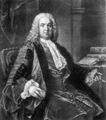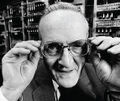Template:Selected anniversaries/August 11: Difference between revisions
No edit summary |
No edit summary |
||
| (One intermediate revision by the same user not shown) | |||
| Line 9: | Line 9: | ||
File:Richard Mead.jpg|link=Richard Mead (nonfiction)|1673: Physician and astrologer [[Richard Mead (nonfiction)|Richard Mead]] born. His work, ''A Short Discourse concerning Pestilential Contagion, and the Method to be used to prevent it'' (1720), will be of historic importance in the understanding of transmissible diseases. | File:Richard Mead.jpg|link=Richard Mead (nonfiction)|1673: Physician and astrologer [[Richard Mead (nonfiction)|Richard Mead]] born. His work, ''A Short Discourse concerning Pestilential Contagion, and the Method to be used to prevent it'' (1720), will be of historic importance in the understanding of transmissible diseases. | ||
||1797: George Shillibeer born ... pioneer of omnibuses. Having founded a coach-building enterprise in Paris (1825), he expanded to include buses. On 4 Jul 1829, he commenced the first regular bus service from London to Paddington, carrying up to 20 passengers and in a coach drawn by three horses. Shillibeer adopted the word omnibus. He boasted it offered a safer and more comfortable ride than ordinary stagecoaches, since all passengers would ride inside. He was followed by imitators then more competition from the discovery that a trolley running on tracks could pull twice the payload. Although Shillibeer had revolutionized London's transport, he went bankrupt and spent time in debtors' prison. He eventually converted his omnibuses into "Shillibeer's Funeral Coaches". Pic. | ||1797: George Shillibeer born ... pioneer of omnibuses. Having founded a coach-building enterprise in Paris (1825), he expanded to include buses. On 4 Jul 1829, he commenced the first regular bus service from London to Paddington, carrying up to 20 passengers and in a coach drawn by three horses. Shillibeer adopted the word omnibus. He boasted it offered a safer and more comfortable ride than ordinary stagecoaches, since all passengers would ride inside. He was followed by imitators then more competition from the discovery that a trolley running on tracks could pull twice the payload. Although Shillibeer had revolutionized London's transport, he went bankrupt and spent time in debtors' prison. He eventually converted his omnibuses into "Shillibeer's Funeral Coaches". Pic. | ||
| Line 75: | Line 73: | ||
||1962: Vostok 3 launches from the Baikonur Cosmodrome and cosmonaut Andrian Nikolayev becomes the first person to float in microgravity. ... the Soviet Union launched cosmonaut Andrian Nikolayev on a 94-hour flight in Vostok III, which set an endurance record at the time. Eighteen months after Yury Gagarin became the first man in space, Nikolayev became Russia's third cosmonaut to travel into space. Pavel Popovich was launched in Vostok IV the next day. The pair made the first simultaneous flights; both returned on 15 Aug. Nikolayev's flight set an endurance record, circling the Earth 64 times in 96 hours, having completed 1,650,000 miles. He returned to space in 1970 for his second and final mission on the Soyuz 9 craft, setting a new endurance record, spending 18 days in space in Soyuz 9. He was twice named a Hero of the Soviet Union. | ||1962: Vostok 3 launches from the Baikonur Cosmodrome and cosmonaut Andrian Nikolayev becomes the first person to float in microgravity. ... the Soviet Union launched cosmonaut Andrian Nikolayev on a 94-hour flight in Vostok III, which set an endurance record at the time. Eighteen months after Yury Gagarin became the first man in space, Nikolayev became Russia's third cosmonaut to travel into space. Pavel Popovich was launched in Vostok IV the next day. The pair made the first simultaneous flights; both returned on 15 Aug. Nikolayev's flight set an endurance record, circling the Earth 64 times in 96 hours, having completed 1,650,000 miles. He returned to space in 1970 for his second and final mission on the Soyuz 9 craft, setting a new endurance record, spending 18 days in space in Soyuz 9. He was twice named a Hero of the Soviet Union. | ||
||1971: Sir John Burton Cleland dies ... was a renowned Australian naturalist, microbiologist, mycologist and ornithologist. He was Professor of Pathology at the University of Adelaide and was consulted on high-level police inquiries, such as the famous Taman Shud Case in 1948 and later. Pic. | ||1971: Sir John Burton Cleland dies ... was a renowned Australian naturalist, microbiologist, mycologist and ornithologist. He was Professor of Pathology at the University of Adelaide and was consulted on high-level police inquiries, such as the famous Taman Shud Case in 1948 and later. Pic. | ||
| Line 91: | Line 87: | ||
||1980: Verner Emil Hoggatt Jr. dies ... mathematician, known mostly for his work in Fibonacci numbers and number theory. Pic: http://faculty.evansville.edu/ck6/bstud/hoggatt.html | ||1980: Verner Emil Hoggatt Jr. dies ... mathematician, known mostly for his work in Fibonacci numbers and number theory. Pic: http://faculty.evansville.edu/ck6/bstud/hoggatt.html | ||
File:Alonzo Church.jpg|link=Alonzo Church (nonfiction)|1995: Mathematician and logician [[Alonzo Church (nonfiction)|Alonzo Church]] dies. He made major contributions to mathematical logic and the foundations of theoretical computer science. | File:Alonzo Church.jpg|link=Alonzo Church (nonfiction)|1995: Mathematician and logician [[Alonzo Church (nonfiction)|Alonzo Church]] dies. He made major contributions to mathematical logic and the foundations of theoretical computer science. | ||
File:Armand Borel.jpg|link=Armand Borel (nonfiction)|2003: Mathematician and academic [[Armand Borel (nonfiction)|Armand Borel]] dies. He worked in algebraic topology, and in the theory of Lie groups, contributing to the creation of the contemporary theory of linear algebraic groups. | File:Armand Borel.jpg|link=Armand Borel (nonfiction)|2003: Mathematician and academic [[Armand Borel (nonfiction)|Armand Borel]] dies. He worked in algebraic topology, and in the theory of Lie groups, contributing to the creation of the contemporary theory of linear algebraic groups. | ||
||2012: Robert Duncan Luce dies ... mathematician and social scientist, and one of the most preeminent figures in the field of mathematical psychology. Pic search. Pic search. | |||
||2015: Richard A. Oriani dies ... chemical engineer and metallurgist who was instrumental in the study of the effects of hydrogen in metal. He also made significant contributions to the field of cold fusion. Pic. | ||2015: Richard A. Oriani dies ... chemical engineer and metallurgist who was instrumental in the study of the effects of hydrogen in metal. He also made significant contributions to the field of cold fusion. Pic. | ||
</gallery> | </gallery> | ||
Latest revision as of 13:03, 7 February 2022
1578: Mathematician, cosmographer, and academic Pedro Nunes dies. One of the greatest mathematicians of his time, he is best known for his mathematical approach to navigation and cartography.
1673: Physician and astrologer Richard Mead born. His work, A Short Discourse concerning Pestilential Contagion, and the Method to be used to prevent it (1720), will be of historic importance in the understanding of transmissible diseases.
1854: Physicist and academic Macedonio Melloni dies. Melloni demonstrated that radiant heat has physical properties similar to those of light.
1921: Mathematician and computer scientist Tom Kilburn born. Over the course of a productive 30-year career, he will be involved in the development of five computers of great historical significance.
1974: Graphic designer and typographer Jan Tschichold dies. He was a leading advocate of Modernist design, but later condemn Modernist design in general as being authoritarian and inherently fascistic.
1995: Mathematician and logician Alonzo Church dies. He made major contributions to mathematical logic and the foundations of theoretical computer science.
2003: Mathematician and academic Armand Borel dies. He worked in algebraic topology, and in the theory of Lie groups, contributing to the creation of the contemporary theory of linear algebraic groups.







